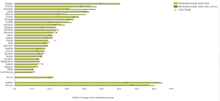




A climate target, climate goal or climate pledge is a measurable long-term commitment for climate policy and energy policy with the aim of limiting the climate change. Researchers within, among others, the UN climate panel have identified probable consequences of global warming for people and nature at different levels of warming. Based on this, politicians in a large number of countries have agreed on temperature targets for warming, which is the basis for scientifically calculated carbon budgets and ways to achieve these targets. This in turn forms the basis for politically decided global and national emission targets for greenhouse gases, targets for fossil-free energy production and efficient energy use, and for the extent of planned measures for climate change mitigation and adaptation.
At least 164 countries have implemented climate targets in their national climate legislation.[4]
- ^ "What is the difference between carbon-neutral, net-zero and climate positive?". plana.earth. PlanA.Earth GmbH. Retrieved 28 February 2024.
- ^ "What does climate positive mean?". go-positive.co.uk. Go Climate Positive Limited. Retrieved 28 February 2024.
- ^ Christiana Figueres u. a. (2017), "Three years to safeguard our climate", Nature (in German), vol. 546, no. 7660, pp. 593–595, Bibcode:2017Natur.546..593F, doi:10.1038/546593a, PMID 28661507
- ^ harrisson, thomas (2017-05-11). "Mapped: Climate change laws around the world". The database, produced by the Grantham Research Institute on Climate Change and the Environment and the Sabin Center on Climate Change Law, includes more than 1,200 relevant policies across 164 countries. Retrieved 2023-08-14.
Cite error: There are <ref group=Note> tags on this page, but the references will not show without a {{reflist|group=Note}} template (see the help page).